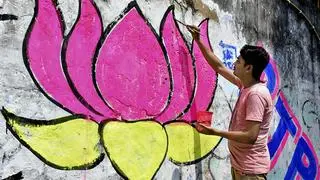When first constituted in 1952, Parliament had 703 members — 499 in the Lok Sabha and 204 in the Rajya Sabha.
Despite a cap of 500, fixed in 1956 via a Constitution Act, the number of Lok Sabha members was increased to 525 in 1973 and 530 in 1987. Now, on a business day with full attendance, the Lok Sabha seats 550 members (the current strength is 545).
Similarly, the seats in the Rajya Sabha also increased, from 204 in 1952 to 228 in 1966 and 233 in 1987. Today, there are 245 seats in the Rajya Sabha, of which 233 are elected and 12 are nominated. The Rajya Sabha should consist of not more than 250 members, by Constitution.
Thus, on days when a joint session of Parliament is held, the potential number of attendees goes up to 802. The Central Hall, where these sessions are held, has limited seating capacity and aisles are used to arrange temporary seats.
The inadequacy of seating, while restricting the movement of members, also poses challenges for evacuation should the need arise.

Latest infrastructure
This, along with the manifold increase in the number of people working in the Parliament building, the growing number of visitors, and outdated amenities and technological infrastructure, has constantly entailed upgradations and renovations in the present Parliament building.
This necessitates a move to a new facility, according to a paper prepared by the Lok Sabha Secretariat.
The new building will have a Lok Sabha chamber that is almost thrice the present one in size; the Rajya Sabha chamber will be four times as big. It will not have a central hall. Instead, the Lok Sabha chamber will have a seating capacity of 1,224, big enough for a joint session.
Potential increases
The Rajya Sabha chamber will have a capacity to seat 384 members.
This is to accommodate the potential increase in the number of legislators after Census 2026 and even more in the future.
The new complex will be built on a 64,500 sq m area, at an estimated cost of ₹971 crore, to be completed in time to commemorate 75 years of Independence.
Tata Projects Ltd won the bid to construct the building, for ₹861.9 crore.
The new structure will be built with a utility horizon of 100 years. Incorporating state-of-the-art technology with room for upgradeability, facilities for members to move seamlessly between houses, modern communication facilities, up-to-date safety norms and adequate safeguards for natural emergencies (New Delhi and surrounding areas follow earthquake Zone V regulations) will be high on the agenda, going by the Lok Sabha document.
The construction is part of the ₹22,000-crore Central Vista Project.
Heritage building
The present structure is a heritage building constructed between 1921 and 1927 at a cost of ₹83 lakh.
It was inaugurated on January 18, 1927 by Lord Irwin, the then Viceroy of India. The first meeting of the Central Legislative Assembly took place the next day, marking the beginning of representative rule in India.
The Assembly had three segments — a Legislative Assembly chamber that could seat 163, a chamber for the Council of State seating 92, and a hall for the Chamber of Princes with seats for 86. “The central circular building is large enough to accommodate an assembly of all three chambers,” the media noted at that time.
Once the new building is inaugurated, the present Parliament House will be preserved as a national archaeological asset.








Comments
Comments have to be in English, and in full sentences. They cannot be abusive or personal. Please abide by our community guidelines for posting your comments.
We have migrated to a new commenting platform. If you are already a registered user of TheHindu Businessline and logged in, you may continue to engage with our articles. If you do not have an account please register and login to post comments. Users can access their older comments by logging into their accounts on Vuukle.